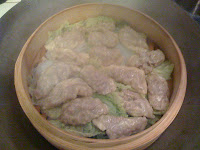 Here's my favorite Chinese treat. Maybe when I make it, it's not so Chinese, but I can always try to emulate the best, can't I?
Here's my favorite Chinese treat. Maybe when I make it, it's not so Chinese, but I can always try to emulate the best, can't I?By the way, if you're ever in Houston, the Dumpling King restaurant has the best dumplings in town. I used to like Lai Lai Dumpling House, down in Chinatown, but the dough on those is too chewy.
But I digress...
Start with:
- 1 pound ground pork
- 1 tbsp sesame oil
- 2 tbsp fresh chopped ginger
- 4 cloves fresh chopped garlic
- about 1 cup fresh chopped cabbage (I've used the regular green cabbage, Napa, or bok choi)
- 4-6 big cabbage leaves
- serving stuff (vinegar, soy, pepper sauce)
- won ton wraps (or if you can't find those, egg roll wraps, cut in half, (or if you can't find those, google how to make your own damn wraps! it's just flour and water)) If you have access to a Chinese grocery, you'll be able to find proper circular wraps.
Before you prepare the chopped cabbage, salvage a few big leaves from the outside of the cabbage. You need enough to cover the bottom of your steamer. This recipe will fill up about four bamboo steamers (I usually make about 1/2 pound of meat, and it will fill up my stack of two steamers). If you don't have a steamer, it's OK. Do the pan-fried thing. I've got a posting on pan-fried lamb dumplings from October 2007 in this blog, so after forming your dumplings, move on down to that post.
Start by sauteeing the garlic and ginger in the oil। Once the garlic is translucent, brown the meat in the flavored oil। Drain all the fat you can, once that's done. You then want to have the chopped cabbage tossed with the meat in a bowl. It's best to have the cabbage chopped pretty fine, and toss it with the meat while the meat is still hot, so it will soften. Sharp edges will tear through the tender won ton wraps, and we don't want that, do we?
I'll frequently toss this mixture with an added 1 or 2 teaspoons of flour or cornstarch to help it stick together. Since we're just using ground meat, it's not excited about holding together in a proper dumpling formation. I typically put this mixture in the fridge for half an hour to let it cool a bit. Seeing as I'm about to work with it with my bare hands, I've found that to be a pretty good practice.
To make the dumplings, have a bowl of water and your wraps out. Some folks use egg yolk instead of water - it does have better adhering properties. I like to have a damp towel handy to wipe my hands periodically while I'm doing this (especially if I'm using the egg!).
Moisten the four sides of the wrap. Take a small spoonful of the flavored meat and place it in the middle. I like to take two diagonal corners and press them together (they should stick with the moistening) making a hammock like tube. I then take the other two corners and tuck them under the raised corners. They can't actually tuck under completely - what you want is to get them to paste to the underneath edges of the top corners. You should have an oblong dumpling now. Then seal it shut by taking the thumb and forefinger of both hands next to each other pressing and twisting from one side to the other until you have a classic dumpling shape. It's hard to describe without pictures, but I've found videos on You Tube, so if you can't figure it out, do a little research. After awhile you'll figure out what works for you. Everybody has his/her own style.
To steam, place the dumplings on top of the cabbage leaves in the steamer. If the water is already boiling, it should take 5 to 10 minutes, as the meat is already cooked. You'll know they're done when the wraps look almost translucent. I have one of those two-high bamboo steamers, and I place them in my wok to do this.
Serve with the usual fixin's - I like rice vinegar and pepper sauce, and sometimes soy sauce. The cabbage should be served as an accompanyment.
One note - all of the recipes I've read have you make the dumplings with raw meat and boil them for about six minutes. That will give you a more solid filling than what pre-cooking gives you. I pre-cook for two reasons - one to remove a lot of the fat, two, to make sure the meat is cooked through, and three, to keep the dumplings from falling apart (always a risk). But i've never tried the boiling method - I will do so and write about it one of these days.
